Old and New: Mark Podwal’s Textiles for the Altneuschul in Prague
Mark Podwal is a busy, busy man. When I wrote that in these pages in September, 2010 it is now clear I didn’t know the half of it… witness his current exhibition at Yeshiva University Museum. In what is effectively a love song to his adopted city, Prague, Podwal has had the delicious opportunity to give her Jewish community a spanking new Chanukah gift; the new Torah curtain, shulhan covers and Torah mantles. For a Jewish artist and lover of Prague like Podwal it doesn’t get any better than that.
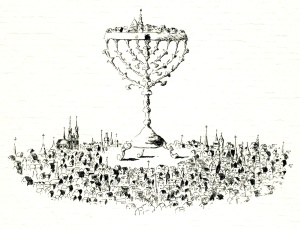
Curator Zachary Paul Levine’s exhibition brilliantly contextualizes Podwal’s textile creations both within the artist’s own work and the historical background of the ancient Jewish community. Additionally, Levine produced and edited “Steps Closer to Prague: Mark Podwal,” a 9 minute video companion on YouTube that not only includes considerable commentary by the artist himself, but also explores the working relationship he developed with the New York custom embroidery company, Penn and Fletcher. From Podwal’s original drawings to digital transfers and computer driven machine-made embroidery finally appliqued on the final textile, each step is lovingly documented. The combination is a captivating and intense course in Jewish visual symbols, Czech Jewish history and contemporary Jewish art.
Podwal’s interest in Prague and its Jewish community dates back to the late 1970’s when he was researching material for a book with Elie Weisel on the mythical Golem of Prague. His fascination at first centered on the old Jewish cemetery, used from 1439 until 1787, and home to an estimated 12,000 tombstones and perhaps as many as 100,000 burials. This eerie hodgepodge of Jewish history, piety and life prompted many drawings and paintings by him, often morphing into fantastic visions of multiple golems and claustrophobic ghetto houses. His drawings of the cemetery are the beginning of the exhibition’s tale that traces many of the visual elements of these current textiles back to his earlier work.
Golem and cemetery images surround an open model of the seven hundred year old Altneuschul to familiarize us with the new home of Podwal’s textiles. We see the how the shul is effectively divided into three sections by two massive pillars, reminiscent of legendary columns Boaz and Jachin found at the entrance of the First Temple. The front section was for the holy, i.e. prayer, while the remaining rear sections were utilized for communal affairs, dominated by the enormous medieval guild banner, proudly bearing the Star of David, evidently the earliest use of this symbol in a synagogue. Also noted on the accompanying text panels are the numerous symbolic references throughout the shul; the 12 grape vines on the valance over the Aron symbolizing the 12 tribes; the 12 windows to the outside world reflecting the same and the abbreviated quotations of psalms emblazoned on the walls. Echoes of all these elements are found in Podwal’s Altneuschul textiles.
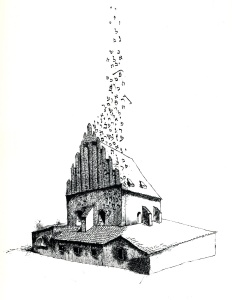
Prague’s Jewish community has been on Podwal’s mind for decades. Two drawings exemplify his curious meditations. Touching Heaven is brazen in its assertion that the Jewish community of Prague is somehow elevated over all others in their city by the mere fact of their Judaism. Towering over a multitude of spires (Prague is known as City of a Hundred Spires), Podwal has shown the little Jewish ghetto, itself dominated by the Altneuschul, ensconced on a massive menorah towering over the city. This audacious image leads one naturally to Podwal’s more localized Old-New Synagogue that exposes the real agenda in these images. Here we see the Altneuschul in realistic profile with hundreds of Hebrew letters ascending to heaven. In itself not at all surprising since we believe that all of our prayers, especially in those uttered in shul, ascend to heaven, nonetheless, here Podwal touches on a particular piece of Prague Jewish belief. According to legend the Altneuschul was itself built with stones from the Second Temple and in the time of the Messiah is destined to eventually return to Jerusalem. It is therefore is especially connected with Jerusalem and the Heavenly realm.
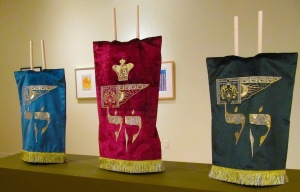
As audacious a belief as this seems, it actually is understandable in light of another legend (claimed to be ancient but probably a 19th century creation) of the Golem that was created by Rabbi Judah Loew ben Bezalel, chief Rabbi of Prague. The legend describes a deeply pious Jew mystically giving life to a creature crafted from earth to defend the threatened Jews of Prague. Much like God created Man, this human creation is deeply rooted in the holy and depicts man as potentially God-like as a mere mortal could possibly attain. Hence Prague’s closeness to Heaven itself.
Podwal’s designs are brimming with symbols that anchor them in the very fabric of the Prague Jewish community. The three Torah covers are boldly emblazoned koof – lamed standing for Kodesh l’Hashem, Holy to the Lord as is surely the Torahs they cover. Central to this design is the elaboration of the lamed; known as the majestic letter, symbolic of the King of Kings, towering over all the others. He has used the grand guild banner from the Altneuschul itself as the lordly upper arm. This conflation of Prague Jewish civic pride with the Hebrew letter that connects to the Divine name reflects both the struggles and success of the community’s Jews with the city of Prague. It proclaims: Prague Jews are true to God and are here to stay!
On the Shulhan and Stender covers Podwal employs the heraldic Lion of Judah (here with two tails) as ferocious guardians. On the Shulhan they stand at the ready flanking the Choshen haMispat, the Breastplate of Judgment, worn by the High Priest. This represents the Crown of Priesthood, first honored whenever the Torah is read. The Stender is similarly guarded by these very special lions, there framing an open book representing the siddur that is at the ready for the Sheleach Tzibor, the prayer leader. In both these designs Podwal has referenced the actual uses that his textiles facilitate. The Torah must be blessed before public reading, preferably first by a cohen. His honor is paramount and is celebrated in Podwal’s design. So too the prayer leader, the open book of the siddur is his duty and glory to explicate for the congregation in his leadership of public prayer. The open book is his opportunity to lead the congregation to the Divine.
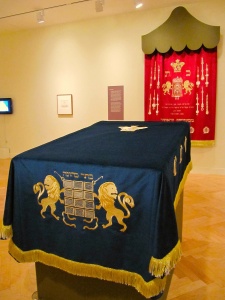
Crowning the exhibition is the paroches itself that is symphony of proud Czech Jewish symbols. Emblazoned at the prayer leader’s eyelevel is “Mimaamikim chrosiha,” (From the Depths I called You) in the Hebrew font used in the famous 1526 Prague Haggadah. The traditional columns found on many Bohemian Torah curtains have been replaced by two columns of Torah pointers, each derived from actual pointers found in the Prague Jewish museum. Their twelve hands point up in a salutation and celebration of the One Above. Again we see the rampant lions with their distinctive double tails, incorporating the heraldic symbol found on the Bohemian Coat of Arms. This testifies both to the Tribe of Judah (i.e. Jewish Kingship) and the sovereign region of Bohemia. These lions are seen holding a Torah, itself laden with symbols. This little Torah’s mantle reflects subtly different aspects of Podwal’s design. We see again two lions atop two actual columns proudly framing the Ten Commandments and holding the Crown of Torah above it all.
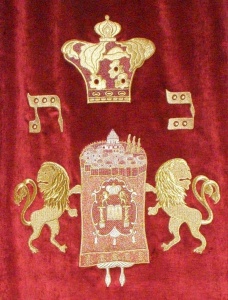
Most significantly the Torah depicted on the paroches is crowned with the walled Ghetto of Prague, the Altneuschul as its central and most prominent landmark. This Torah crowned with the Altneuschul is an absolutely unique image in which the source of every Jew’s faith, the Torah itself, is crowned with the place of a Prague Jew’s devotion, the Altneuschul. It is as if Podwal has embodied the phrase from the kedushah; “Blessed is the glory of Hashem from His Place” as the emblem of the Altneuschul.
At the very heart of Podwal’s Torah curtain design is a celebration of the Prague Altneuschel community and its physical presence. Every aspect of this Torah curtain fittingly refers back to the home it will soon occupy. In light of these new Torah ornaments the Prague Jewish community stands proud in its commitment to its own sacred history and its commitment to the city of Prague and its larger community. Mark Podwal’s gift to the Jews of Prague reverberates to all Jews who understand exactly how important and sacred our own synagogues are to each and every one of us.
Old and New: Mark Podwal’s Textiles for the Altneuschul in Prague
Yeshiva University Museum – Center for Jewish History
15 West 16th Street, New York, N.Y.; (212) 294 8330
www.yumuseum.org
Sunday, Tuesday, Wednesday, Thursday 11am-5pm
$6 adults, $4 children
Until January 15, 2012